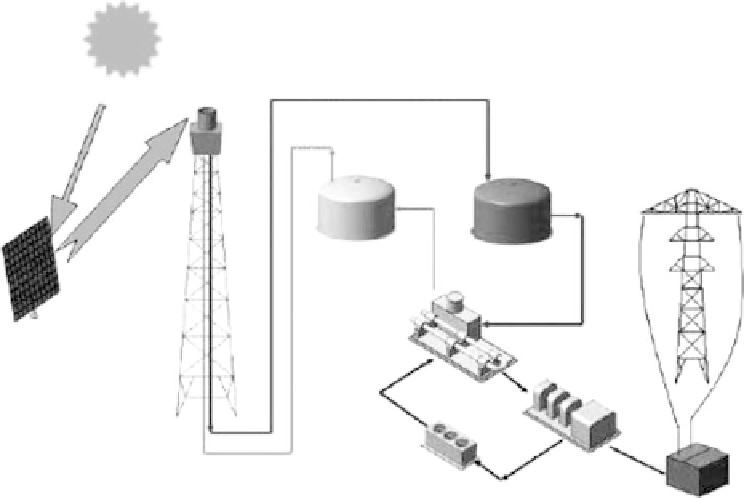Environmental Engineering Reference
In-Depth Information
SALT
565
°
C
RECEIVER
790
°
C
COLD SALT
STORAGE TANK
HOT SALT
STORAGE TANK
SALT
STEAM
GENERATOR
HELIOSTAT FIELD
TURBINE
GENERATOR
CONDENSER
SUBSTATION
Figure 14.4.1
Example of power plant layout with the two tanks direct storage system (Gil et al., 2010).
molten salts), heated by the HTF circulating in the solar field and pumped through heat
exchangers (generally synthetic oil). During a thermal storage charge cycle, a portion of
the oil from the solar field is directed to the oil-to-salt heat exchanger: molten salts are
taken from the cold storage tank and flow in a counter current arrangement through
the heat exchanger. During the discharge cycle, the oil and salt flow paths are reversed
in the oil-to-salt heat exchanger; heat is then transferred from the salt to the oil to
provide the thermal energy for the steam generator.
Another active indirect storage system is the
single-tank system
, in which hot and
cold fluids are stored in the same tank (see Figure 14.4.3). Equipping the system with
a thermally stratified tank (thermocline) is a potential way of reducing the cost of
the plant. The HTF from the solar field passes through a heat exchanger, heating the
thermal storage fluid media. Usually, a filler material can be used to aid stratification
and reduce the quantity of heat transfer fluid. Experimental studies performed up to
now have found that this filler material, depending on the type, can also act as a ther-
mal energy storage medium. Recent research projects conducted by Sandia National
Laboratories have identified quartzite rock and silica sands as potential filler materials
(Brosseau et al., 2005). Depending on the cost of the storage fluid, the thermocline
can result in a substantially lower cost storage system (Gil et al., 2010). The advan-
tages of the single-tank thermocline system are: reduced storage tank costs and lower
cost of the filler materials (rocks and sand). A thermocline system has been estimated
to be about 35% cheaper than the two-tank storage system (Brosseau et al., 2005).

Search WWH ::

Custom Search